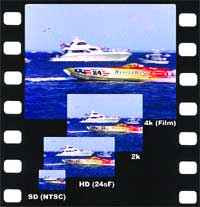
While video has a fixed resolution, data can be anything.
|
Is the day approaching when professional, high-end post means dealing primarily with data? And the mid-level market is made up mostly of video post? Not yet. But it is coming. Here's why.
Over the past 40 years, the video post production industry has honed its tools and skills to provide efficient and cost effective services. All the while, there's been a steady progression to higher quality as technology advances. The key benefits of video post production are realtime transfer, recording and playback of material; a variety of tape formats for storage and delivery; video masters are ideal for television and home video; there are well-established methods of working and a wealth of professionals to advise on everything from designing a facility to making a standards conversion.
ACCEPTED WORLDWIDE
Despite all the advances in video technology, film, with its 100-plus years of existence, is still considered the most desirable source medium. But recent developments in HDTV are challenging film's dominance, even though 35mm still has far greater color space and contrast range. Film's extended latitude and the desire by top producers to achieve ever-higher quality production is leading them straight to data.
Like film, data files are accepted worldwide. There are no regional PAL/NTSC standards to deal with, and no interpolation is necessary. Its higher resolution and contrast range make data ideal for film finishing and compositing. Data is less likely to become obsolete because it is software dependent. Videotape, on the other hand, requires expensive (perhaps obsolete) hardware matching a particular format and standard. Video standards have fixed resolutions whereas data can be any resolution. Data is faithful to the original image quality making it ideal for restoration and archival projects. But most attractive is the concept of the Universal Master. Since a data master is typically in the highest resolution possible, all other formats, including most video standards, can be produced from a single master.
Does working in data require new equipment, a revised business plan and a new generation of specially trained operators? In reality, the equipment, business plan and experienced people are already in place. This is because the telecine, color enhancement and editing tools needed to work in data are found in most high-end facilities. A typical post house might scan film on a Thomson Spirit DataCine, color enhance the material on a da Vinci 2K and perform an online edit with a Discreet Inferno - exactly the same equipment, configuration, operators and business plan necessary to process a project in data.
The similarities in workflow between dealing with video and data go deeper. For example, the da Vinci 2K not only offers identical tools in SDTV, HDTV and data, but session files are intercompatible from format to format. Even the 2K's built-in reference still store operates at all resolutions. Best of all, video from the Spirit DataCine with color enhancement by the da Vinci 2K is assessed on a calibrated video monitor, then switched to data mode for transparent transfer of the corrected, higher resolution files. In this way, colorists and their clients can work in the same comfortable environment they're used to, using the same tools they rely on for their SD and HD projects.
One issue that arises while working in data is that a video monitor cannot display the extended dynamic range of data accurately. In part, colorists learn to predict the projected result. To solve this, da Vinci includes a data monitor output on the 2K for checking the image before and during data transfers.
There are two distinct data flavors at the high end of post production: HIPPI (High Performance Parallel Interface) and HSDL (High Speed Data Link). The HIPPI format has a large installed user base (Thomson Spirit and Shadow telecines).
HIPPI is SGI compatible (Discreet products) and typically transfers resolutions of 2048-by-1556 and 1920-by-1440. Transfer speeds are currently about 4 to 6 fps. Other telecine manufacturers such as Cintel have expressed intentions to support HIPPI. Nice Shoes in NYC is a leader in HIPPI data production.HSDL has much higher data transfer rates (up to 20fps) and uses the in-place facility's HD infrastructure. Resolution is typically 1920-by-1440 10-bit images. Listo in Vienna is a leading European post house using HSDL. Telecine manufacturer ITK, with its Millennium Machine telecine, supports HSDL. The da Vinci 2K supports both HIPPI and HSDL.
The transition period from high-end video to high-end data will probably champion 24sF (segmented frame) or 23.98sF as a video/ data hybrid. Material in 24sF possesses the benefits of realtime transfer and tape storage but has (compressed) resolution close to 2K typical of data projects.
Dave Satin, director of engineering at SMA in NYC, points out, "A 40-minute HDCam tape records about 50 minutes of video at 23.98sF. That's 5,000 feet of near-film resolution without changing magazines. Cost: around $60. And it's reusable. Whereas, 35mm film stock is about $1 per foot, purchased and processed."
So will high-end users deal primarily with data? And will video be the domain of the mid-level market? Yes, just as soon as 2K images can be transferred uncompressed in realtime.